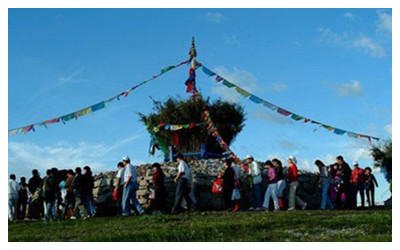Skype: neodalle-travel
Tel: +86 135 7447 2266
E-mail: sales@visitaroundchina.com
 Aobao is translated as a pile of stones in Mongolian. Aobao is generally built in high hills with piles of stones. It has the shape of a round ball, or it is round on its top and rectangular in its base, resembling a beacon tower. There is a long pole sticking to its top; horns of domesticated animals, flags of scriptures and colorful ribbons are tied to the pole. The items inside the Aobaos are various: some have five cereals; some have bows and arrows; some have Buddhist statures. Most of the Aobaos y stand alone on the hills, but there are groups of Aobaos that amount to between 7 and 13 of them. The Aobao standing in the middle is bigger than its surrounding ones. Once Aobaos are built up, every year, the nearby residents will go there and offer sacrifices to pray for a better life. Offering sacrifices to Aobaos is the most important and prevailing sacrificial activity for the Mongolian people. On May 20, 2006, this custom was placed on the first List of Chinese Intangible Cultural Heritages with the permission of the State Council.
Aobao is translated as a pile of stones in Mongolian. Aobao is generally built in high hills with piles of stones. It has the shape of a round ball, or it is round on its top and rectangular in its base, resembling a beacon tower. There is a long pole sticking to its top; horns of domesticated animals, flags of scriptures and colorful ribbons are tied to the pole. The items inside the Aobaos are various: some have five cereals; some have bows and arrows; some have Buddhist statures. Most of the Aobaos y stand alone on the hills, but there are groups of Aobaos that amount to between 7 and 13 of them. The Aobao standing in the middle is bigger than its surrounding ones. Once Aobaos are built up, every year, the nearby residents will go there and offer sacrifices to pray for a better life. Offering sacrifices to Aobaos is the most important and prevailing sacrificial activity for the Mongolian people. On May 20, 2006, this custom was placed on the first List of Chinese Intangible Cultural Heritages with the permission of the State Council.
Historical Origin
The sacrificial activities in Inner Mongolia are various: offering sacrifices to the sky, god of fire, ancestors, Aobao, etc. Among them, offering sacrifices to Aobaos are the most important one and it demonstrates the people of various nationalities living on the grasslands together. In ancient times, the ancestors of the Mongolian people revered the heaven and earth as the sources for human living and multiplying, so they worshiped them devoutly. Since people didn’t know what gods of heaven and earth looked like, they piled up stones (Aobaos) that served as the symbols of gods. By offering sacrifices to Aobaos, they prayed to gods of heaven and earth for a bumper harvest, thrifty animal husbandry and a peaceful life. There is another legend that explains the origin of Aobao. According to this saying, the prairie is so vast and boundless that people could easily lose their ways in the past; thus, they piled up stones as road signs. This was how Aobaos came into being. Later, Aobaos were gradually regarded as places where gods lived in and the people started offering sacrifices to them. In the past, each region, county, village and temple had its own public Aobao and the rich also had their own Aobaos with many names. Aobao, in the Mongolian people’s eyes, is a sacred place. In the old days, when embarking on a long journey, people would dismount their horses and pray to Aobaos for a safe trip once they saw one. They would later add several stones or a handful of earth to the Aobao and then mounted up their horses to continue the journey. It was in the Qing Dynasty that the custom of offering sacrifices to Aobaos annually with each tribe as a unit.
Sacrificial Activities
As the customs and traditions of the herds vary greatly in different regions, not all the time and forms of offering sacrifices to Aobaos are the same. Generally, the time for offering sacrifices is in late May and the beginning of June in Chinese lunar calendar, and sometimes in July and August (in Chinese lunar calendar). During this time, the water is abundant, the grasses are lush and the herds are robust. A single region can offer sacrifices by itself; some regions can jointly do this. The Siklingelei County is the place where the tradition of offering sacrifices to Aobaos is well-preserved.
 Ask Questions ?
Ask Questions ?